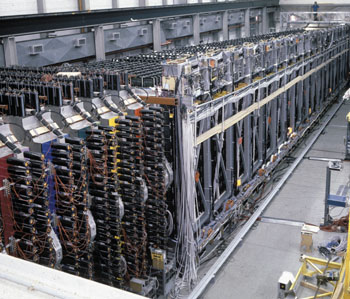Neutrinos have always been in the particle physics spotlight. However, with new machine ideas opening up the possibility of intense neutrino sources, this area of research could go on to reveal further insights into the weakly interacting particles, thereby complementing the detailed knowledge of the quark sector.

With CERN’s LHC collider now committed to beginning its experimental programme in the year 2005, and with research and development work well advanced for a new generation of linear electronpositron colliders, a totally new avenue of particle physics machines that is currently being enthusiastically explored is that involving muon colliders.
Muons, which are heavy relatives of the electron, come in postively and negatively charged versions with properties that are broadly similar to those of electrons. These oppositely charged beams could be made to collide with each other to produce a wealth of particles.
As a result of their being more than 200 times as heavy as electrons, muons that are bent by a magnetic guide field lose much less energy than electrons and could be housed in far smaller rings. Several generations of muon colliders could be accommodated on existing laboratory sites. Initial thinking towards muon colliders was outlined by Fermilab’s Steve Geer in the December 1997 issue (“Muon colliders move nearer”).
Neutrinos from muons
One interesting possibility en route to a full muon collider scenario with two muon beams is to employ a single circulating muon beam. As they decay, the stored muons would provide an intense source of neutrinos with properties that are very different those of conventional synthetic neutrino beams.
The first step would be an intense 2 GeV drive beam of protons from a linear accelerator to produce pions at a secondary target. These pions decay into muons, captured in an intermediate storage ring. The muons would then be accelerated in a booster synchrotron up to 20 GeV or higher.
The faster muons travel, the longer they appear to live.
At rest, a muon lives on average for approximately 2.2 µs. Without the intervention of relativity, even a high-energy muon would travel only around 600 m before it decayed. Under these conditions, few cosmic-ray muons would reach the Earth’s surface and muon storage would not be possible. However, the lifetimes of fast-moving muons are stretched by relativity, thus, the faster muons travel, the longer they appear to live. High-energy cosmic-ray muons easily reach the Earth, and high-energy muons could be stored.
However, for this to occur it is essential for the muons to be accelerated quickly, therby endowing them with an increased lifetime as rapidly as possible. The muon storage “ring” would have 300 m straight sections in which most of the stored muons would decay into electrons, neutrinos and antineutrinos.
Negatively charged muons decay into electrons and equal numbers of muon-type neutrinos and electron-type antineutrinos, while positively charged muons decay into positrons and equal numbers of muon-type antineutrinos and electron-type neutrinos.
Energy spectra
The energy spectrum of the produced neutrinos depends only on the muon energy and their spin orientation. That of the muonneutrinos peaks towards the upper end of the spectrum, towards the energy of the muons, while the electronneutrinos are softer. Decay electrons would be swept away by the storage ring bending magnets.In addition to having a clear energy spectrum, the flux of neutrinos produced in this way can be calculated from the muon population of the storage ring. The intense neutrino fluxes available via this route warrants the label “neutrino factories”.
Neutrinos at accelerator laboratories are traditionally produced via the decay of kaons or pions. The neutrino detector has to be some distance from the production target to allow the pions and kaons sufficient time to decay, and the accompanying muons have to be screened off. A pure neutrino beam is only established some distance away, so that neutrino physics has always been a large-scale operation, requiring large detectors to intercept the dispersed particles.
However, with muon storage rings, the electrons from muon decay could easily be screened off, providing a pure neutrino beam very close to the intense source. New-look compact neutrino detectors could be mounted using state-of-the-art detector technologies to pinpoint the neutrino interactions and thereby open up a new era of neutrino physics.
Oscillating neutrinos
Classically, neutrinos were supposed to be massless and came in three immutable kinds electron, muon and tau according to their particle allegiance. However, experiments studying neutrinos coming the Sun and from collisions of cosmic rays in the atmosphere have led physicists to believe that neutrinos are not immutable or massless. Other hints for neutrino oscillations come from an experiment at Los Alamos.
Endowed with tiny masses, neutrinos can transform into each other in flight, so that what leaves the Sun as an electron-neutrino could become a muon-neutrino as it flies through space, or what leaves an accelerator facility as a muon-neutrino could transform into a tau-neutrino.
Such effects are subtle, and measurements of the neutrino masses and mixing parameters are difficult. However, the intense fluxes provided by neutrino factories would provide optimal conditions, particularly compared with existing (and planned) sources of accelerator neutrinos.





